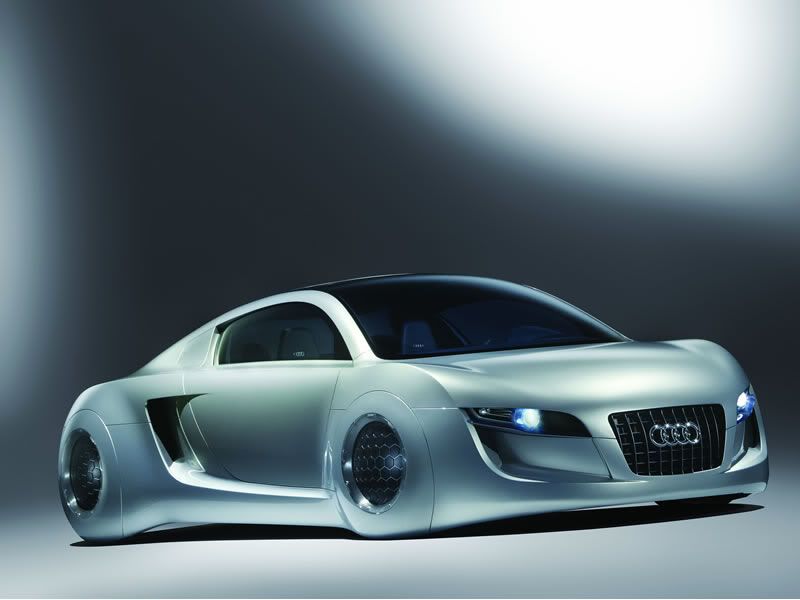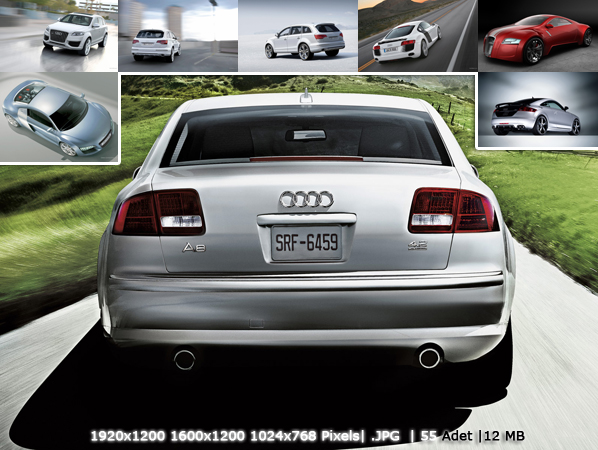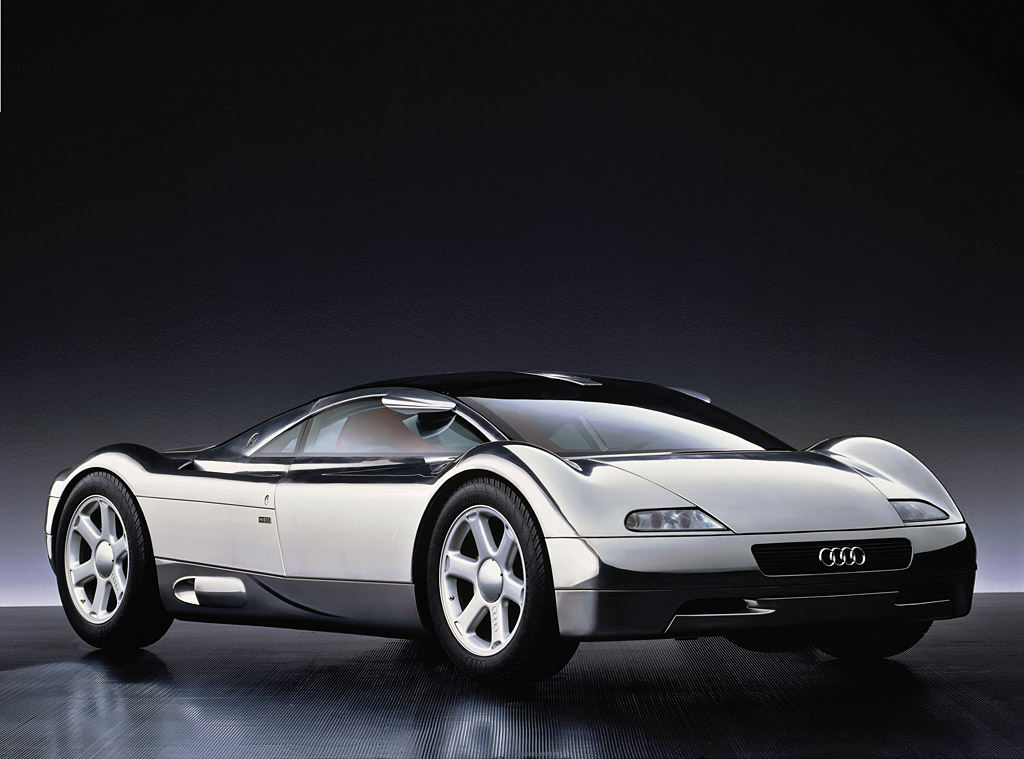 hot audi cars
hot audi cars sports audi cars
sports audi cars fast audi cars
fast audi cars
Audi R-Zero specs
Top Speed: 286 mph / 460 km/h
0-60 mph: 3 seconds
Engine: Four electric in-wheel motors
Among the major head turners in 2006 car shows was the 2006 Audi R-Zero Concept car. Audi has truly outdone itself with this one. The supercar exemplifies the perfect union of the dynamism of sports car designs and the importance and respect it gives for the environment. How's that you might ask? The Audi R-Zero is an electric car.Top Speed: 286 mph / 460 km/h
0-60 mph: 3 seconds
Engine: Four electric in-wheel motors
So if you think all environmental friendly hybrids and other cars are boring and attractive, the 2006 Audi R-Zero Concept car will definitely change your mind. The original concept was a product of the minds of an ingenious group of students hailing from the International School of Design, ISD France. The R-Zero sports car will be equipped with four electric in-wheel motors as its engine. Each engine will be powered by lithium-ion 800 volts batteries that are capable of releasing great mass of power, not less than 450 watts/kg in fact. The supercar will have an estimated weight of 2.2 tons (4,850 lbs), given that the batteries will weigh around 1,200kg and the four engines around 340kg, plus the body weight and accessories. Torque is expected to reach 2,168 lb-ft while horsepower is set at around 1,091 hp at 12,900 rpm. With individual batteries providing power to each individual engine, the sports car is estimated to go at a top speed of 460 km/h (286 mph), with the fast car capable of going from 0-100 km/h in less the 3 seconds. Now, who's going to say that an environmental friendly, electrical-powered car is sissy?
The great thing about the R-Zero sports car are the engines themselves. Not only do the engines protect the environment by not consuming fossil fuels, the electrical motorization is able to transmit great power to the engine as well as bring out high reactivity.
But the R-Zero has more to offer. Now the Audi R Zero Concept is actually a concept car that has its foundations in the popular two-seater super sports car Audi TT and the . The car itself was made using a superstructure that allows air to flow and cool the motor and the brakes. The airflow creates a steady aerodynamic support as well. These attributes and characteristics, of course, brought forth the supercar's optimum performance.
One of the fast car's major attributes is a front latticed grille with a chrome frame where you can find the Audi emblem. The front headlights are made from LED technology and are divided into three separate parts, each made to serve specific purposes. If you look at the R-Zero's curves and design, you will have a Zen like impression of calmness, but at the same time will be affected by the car's voracious nature appeal.
The electric car's wheels are also unique. The 5-wide-radial wheel discs are basically massive. They have been set in low-profile Michelin tires. The large air-cooled disc brakes with red colored brake stirrups can be clearly seen from the spokes of the radial wheel.
Given its specifications, the 2006 Audi R-Zero Concept car is by far the most revolutionary car that came out in the past years. The technology behind this supercar will be astonishing and accomplishing it will be a great feat, both for man and Mother Nature.

Audi AG is a German automobile manufacturer with headquarters in Ingolstadt, Bavaria, and has been an almost wholly owned (99.7%) subsidiary of the Volkswagen Group since 1964. The company evolved from Auto Union, NSU, Horch and DKW, the former having incorporated the historic Audi company which was founded in 1910.
Audi's corporate tagline is Vorsprung durch Technik, the English translation meaning Advantage through Technology or Head Start through Technology. This German-language tagline is also used in other European countries, including the UK, and in other markets, such as Latin America, Oceania and parts of Asia including Japan. The American and Canadian tagline is Truth in Engineering.
History
The origins of Audi
The company traces its origins back to 1899 and August Horch. The first Horch automobile was produced in 1901 in Zwickau. In 1909, Horch was forced out of the company he had founded. He then started a new company in Zwickau and continued using the Horch brand. His former partners sued him for trademark infringement and a German court determined that the Horch brand belonged to his former company. August Horch was forced to refrain from using his own family name in his new car business. Horch immediately called a meeting at the apartment of Franz Fikentscher to come up with a new name for his company. During this meeting Franz's son was quietly studying Latin in a corner of the room. Several times he looked like he was on the verge of saying something but would just swallow his words and continue working, until he finally blurted out, "Father - audiatur et altera pars... wouldn't it be a good idea to call it audi instead of horch?". "Horch!" in German means "Hark!" or "listen", which is "Audi" in Latin. The idea was enthusiastically accepted by everyone attending the meeting. It is also popularly (but incorrectly) believed that Audi is an acronym which stands for "Auto Union Deutschland Ingolstadt".
Audi started with a 2612 cc (2.6 liter) four cylinder model followed by a 3564 cc (3.6 L) model, as well as 4680 cc (4.7 L) and 5720 cc (5.7L) models. These cars were successful even in sporting events. August Horch left the Audi company in 1920. The first six cylinder model, 4655 cc (4.7 L) appeared in 1924. In 1928, the company was acquired by Jørgen Rasmussen, owner of DKW, who bought the same year the remains of the US automobile manufacturer, Rickenbacker including the manufacturing equipment for eight cylinder engines. These engines were used in Audi Zwickau and Audi Dresden models that were launched in 1929. At the same time, six cylinder and four cylinder (licensed from Peugeot) models were manufactured. Audi cars of that era were luxurious cars equipped with special bodywork.
The Auto Union era
In 1932 Audi merged with Horch, DKW and Wanderer to form Auto Union.
Before World War II, Auto Union used the four interlinked rings that make up the Audi badge today, representing these four brands. This badge was used, however, only on Auto Union racing cars in that period while the member companies used their own names and emblems. The technological development became more and more concentrated and some Audi models were propelled by Horch or Wanderer built engines. During World War II, the Horch/Auto Union produced the Sd-Kfz 222 armored car, which was used in the German army during the war. It was powered by an 81 hp (60 kW) Horch/Auto Union V8 Engine which had a top speed of 50 miles per hour.
Another vehicle which was used in World War II to shuttle German military officials safely was known as the Kraftfahrzeug (KFZ 11) or the Horch Type 80. The military used it as a light transport vehicle.
The four-ring logo
The Audi emblem is four overlapping rings that represent the Auto Union. The Audi emblem symbolizes Audi amalgamation of Audi with DKW, Horch and Wanderer: the first ring represents Audi, the second represents DKW, third is Horch, and the fourth and last ring Wanderer
The modern era of Audi

audi cars pics The new merged company was known as "Audi NSU Auto Union AG", and saw the emergence of Audi as a separate brand for the first time since the pre-war era. Volkswagen introduced the Audi brand to the United States for the 1970 model year.
The first new car of this regime was the Audi 100 of 1968. This was soon joined by the Audi 80/Fox (which formed the basis for the 1973 Volkswagen Passat) in 1972 and the Audi 50 (later rebadged as the Volkswagen Polo) in 1974. The 50 was a seminal design in many ways, because it was the first incarnation of the Golf/Polo concept, one that led to a hugely successful world car.
The Audi image at this time was a conservative one, and so, a proposal from chassis engineer Jörg Bensinger was accepted to develop the four-wheel drive technology in Volkswagen's Iltis military vehicle for an Audi performance car and rally racing car. The performance car, introduced in 1980, was named the "Audi Quattro," a turbocharged coupé which was also the first German large-scale production vehicle to feature permanent all-wheel drive through a center differential (not counting the earlier British Jensen FF, produced in small numbers). Commonly referred to as the "Ur-Quattro" (the "Ur-" prefix is a German augmentative used, in this case, to mean "original" and is also applied to the first generation of Audi's S4 and S6 sport sedans, as in "UrS4" and "UrS6"), few of these vehicles were produced (all hand-built by a single team) but the model was a great success in rallying. Prominent wins proved the viability of all-wheel drive racecars, and the Audi name became associated with advances in automotive technology.
In 1985, with the Auto Union and NSU brands effectively dead, the company's official name was now shortened to simply "Audi AG".
In 1986, as the Passat-based Audi 80 was beginning to develop a kind of "grandfather's car" image, the type 89 was introduced. This completely new development sold extremely well. However, its modern and dynamic exterior belied the low performance of its base engine, and its base package was quite spartan (even the passenger-side mirror was an option.) In 1987, Audi put forward a new and very elegant Audi 90, which had a much superior set of standard features. In the early nineties, sales began to slump for the Audi 80 series, and some basic construction problems started to surface.
This decline in sales was not helped in the USA by a 60 Minutes report which purported to show that Audi automobiles suffered from "unintended acceleration". The 60 Minutes report was based on customer reports of acceleration when the brake pedal was pushed. Independent investigators concluded that this was most likely due to a close placement of the accelerator and brake pedals (unlike American cars), and the inability, when not paying attention, to distinguish between the two. (In race cars, when manually downshifting under heavy braking, the accelerator has to be used in order to match revs properly, so both pedals have to be close to each other to be operated by the right foot at once, toes on the brake, heel on the accelerator; a driving technique called heel-and-toe). This did not become an issue in Europe, possibly due to more widespread experience among European drivers with manual transmissions.
60 Minutes ignored this fact and rigged a car to perform in an uncontrolled manner. The report immediately crushed Audi sales, and Audi renamed the affected model (The 5000 became the 100/200 in 1989, as it was elsewhere). Audi had contemplated withdrawing from the American market until sales began to recover in the mid-1990s. The turning point for Audi was the sale of the new A4 in 1996, and with the release of the A4/6/8 series, which was developed together with VW and other sister brands (so called "platforms").
In the early part of this century, Audi set forth on a German racetrack to claim and maintain several World Records, such as Top Speed Endurance. This effort was in-line with the company's heritage from the 1930's racing era "Siver Arrows".
Currently, Audi's sales are growing strongly in Europe. 2004 marked the 11th straight increase in sales, selling 779,441 vehicles worldwide. Record figures were recorded from 21 out of about 50 major sales markets. The largest sales increases came from Eastern Europe (+19.3%), Africa (+17.2%) and the Middle East (+58.5%)[citation needed]. In March of 2005, Audi is building its first two dealerships in India following its high increase in sales in the region.
Audi has recently started offering a computerised control system for its cars called Multi Media Interface (MMI). This comes amid criticism of BMW's iDrive control, essentially a rotating control knob designed to control radio, satellite navigation, TV, heating and car controls with a screen. MMI has been widely reported to be a considerable improvement when compared to BMW's iDrive. (BMW has since made their iDrive more user friendly.)
MMI has been generally well-received, as it requires less menu-surfing with its mass of buttons around a central knob, with shortcuts to the radio or phone functions. The screen, either colour or monochrome, is mounted on the upright dashboard, and on the A6 and A8, the controls are mounted horizontally. However, an "MMI Like" system is also available on the Audi A3 and A4 models when equipped with the optional Navigation System.
 audi cars picture
audi cars picture audi cars pic
audi cars pic
The Audi Avus Quattro was a supercar-styled concept car from the German car manufacturer, Audi. It was first introduced at the 1991 Tokyo Motor Show. The Avus Quattro had an aluminum exterior, which made it a lightweight, sleek and safer automobile. The Avus Quattro’s engine was supposed to be a 6.0 L 60-valve 12-cylinder engine producing 509 hp (380 kW), capable of accelerating the car from 0 to 60 mph (97 km/h) in about 3 seconds and a top speed of 211 mph (340 km/h). The exact car shown at the Tokyo Motor Show, however, had a dummy made of carefully painted wood and plastic for an engine because at the time, such a powertrain was still in development; Audi-made W12 engines were not available to buyers until Audi presented its flagship A8 a few years later.
No comments:
Post a Comment